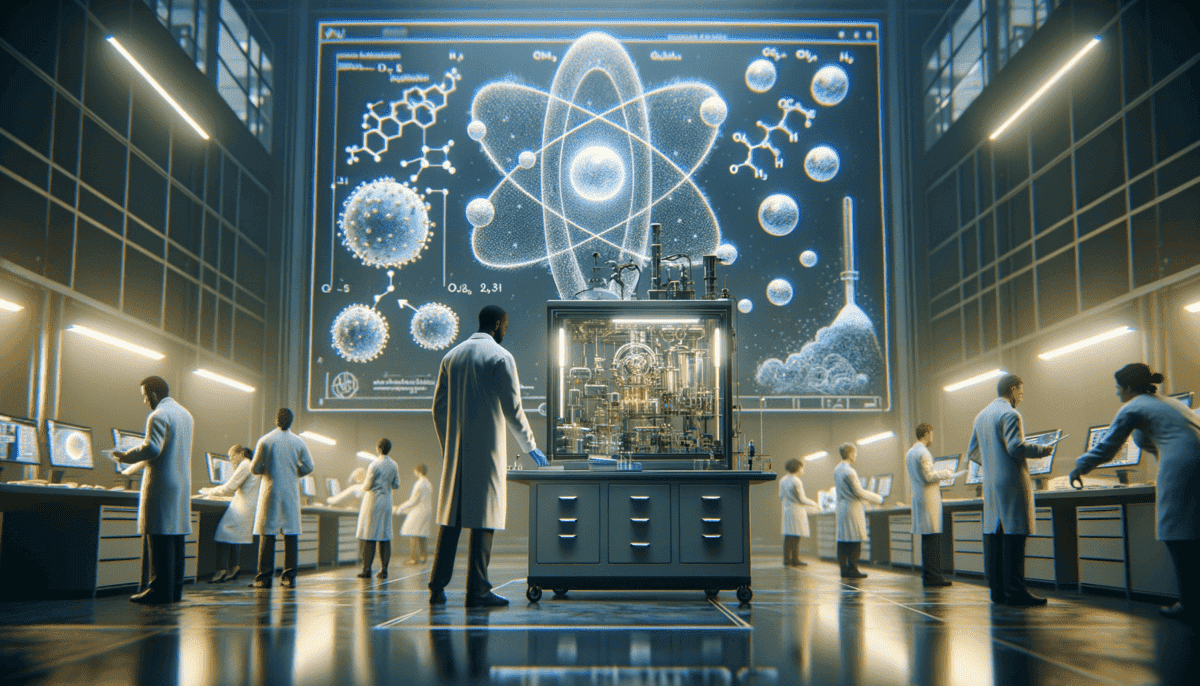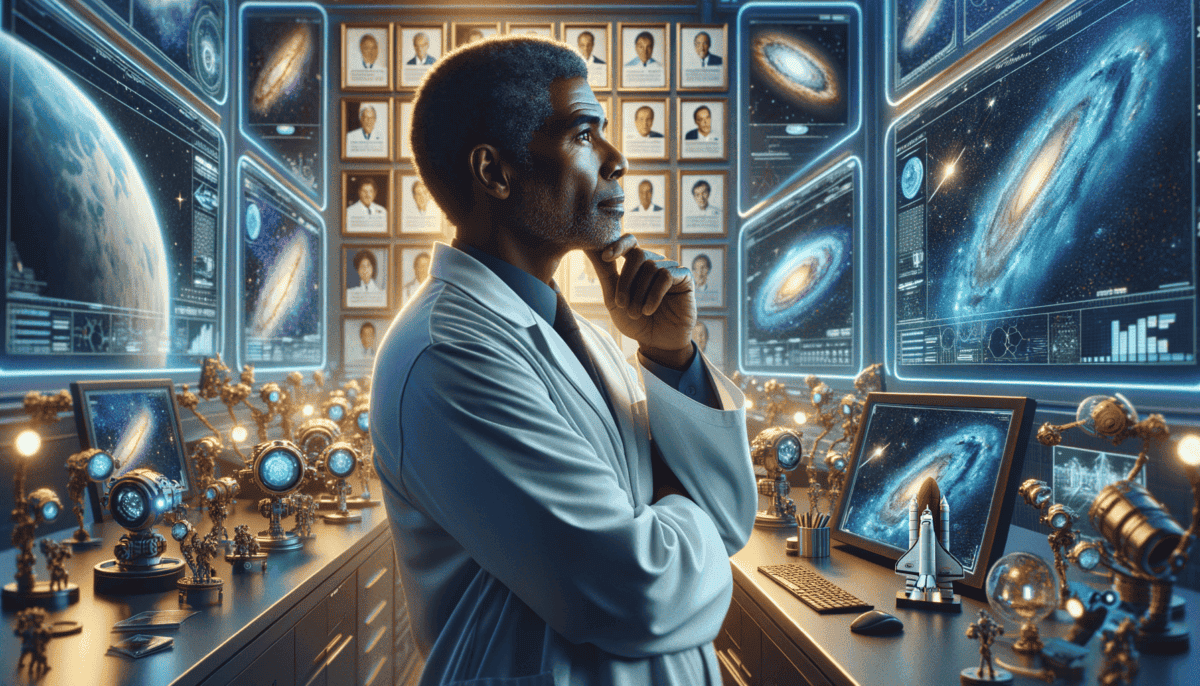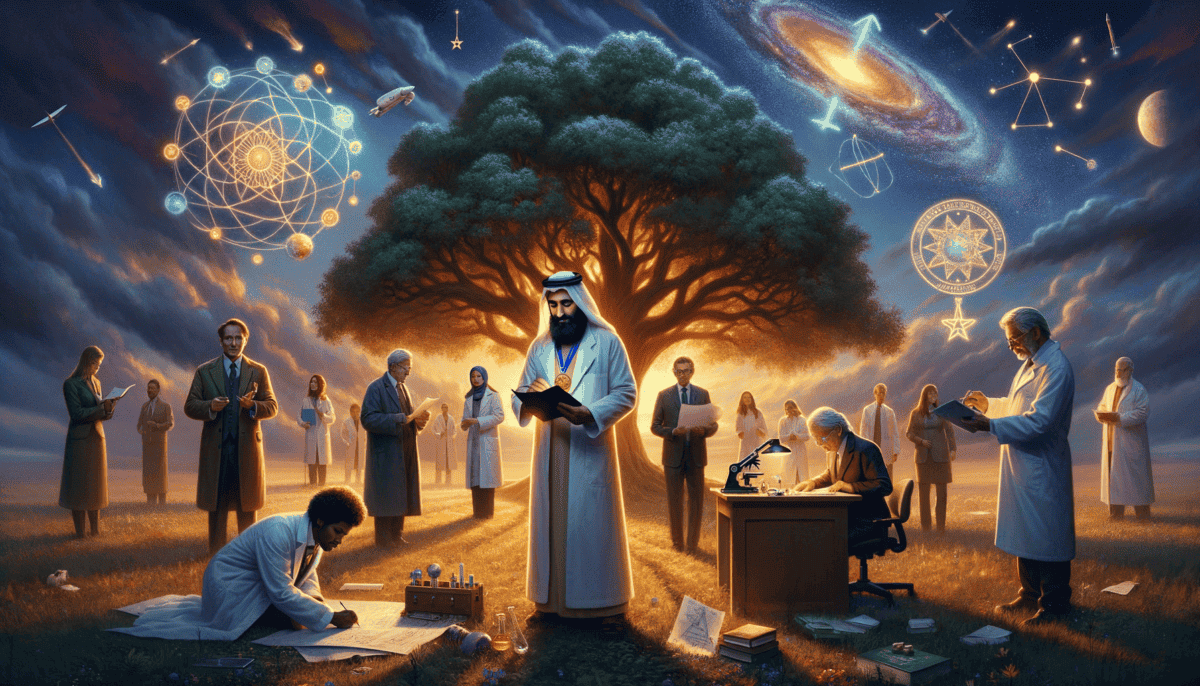Dreams Under the Sky
Little George loved to look at the stars. Every night in Cincinnati, Ohio, he would sit by his window and gaze up at the twinkling lights above. The year was 1947, and seven-year-old George Carruthers had just gotten his first science book from his dad.
"Daddy, what's out there?" George asked one evening, pointing to the night sky.
His father, a civil engineer, smiled. "So many wonderful things, son. Planets, stars, and mysteries waiting to be solved."
George's eyes sparkled with excitement. He would spend hours reading his father's science books and magazines. While other kids played with toy cars, George built rockets from cardboard boxes.
But life wasn't always easy for young George. Being an African American boy in the 1940s meant facing many challenges. Some people told him he couldn't be a scientist because of the color of his skin. But George didn't listen to them. He kept dreaming big.
"Mom," he said one day while helping with dishes, "I want to study the stars when I grow up."
His mother hugged him tight. "Then that's exactly what you'll do, George. Don't let anyone tell you different."
When George was twelve, something sad happened. His father passed away. But before he did, he left George with something special – a love for science and learning that would last forever.
“The stars became my friends,” George would later say. “They helped me feel close to my dad.”
In school, George joined the science club. While some kids found science hard, George thought it was like solving fun puzzles. He started reading about space in the library and learned about something called "astronomy" – the study of stars and space.
His teachers noticed how smart he was. One day, his science teacher, Mrs. Thompson, gave him a special gift – a real telescope!
"Now you can see the stars up close," she said with a smile.
George spent that whole summer looking through his telescope. He saw:
- The rings of Saturn
- The craters on the Moon
- The red spot on Jupiter
- Twinkling stars of different colors
Each night brought new discoveries. George wrote everything down in his notebook, drawing pictures of what he saw. He was becoming a real scientist, even if he didn't know it yet.
Sometimes, the other kids made fun of him for spending so much time studying. But George didn't mind. He knew that every great scientist had to work hard to achieve their dreams.
"One day," he told his mother, "I'm going to invent something that will help us see things in space that no one has ever seen before."
His mother smiled. She knew her son was special. "Keep dreaming big, George," she said. "The sky isn't the limit – it's just the beginning."
Every night, before going to bed, George would look out his window one last time. The stars seemed to twinkle just for him, like tiny lights guiding him toward his future. He didn't know it then, but those childhood dreams under the Cincinnati sky were the first steps toward becoming one of America's most important space scientists.
Growing Dreams into Reality
Young George Carruthers walked into his first college class at the University of Illinois. His heart was beating fast. It was 1957, and not many Black students were studying physics. But George remembered his mother’s words: “Keep going, no matter what.”
“Welcome to Physics 101,” the professor said. George sat up straight, ready to learn everything he could about science.
College wasn’t easy. George had to study hard. Sometimes he was the only Black student in class. But he kept thinking about the stars and his dream of seeing them in new ways.
“Why can’t we see what stars are made of?” George asked one day in class.
His professor smiled. “That’s a great question! Maybe you’ll be the one to figure it out.”
“I learned that the best way to solve a problem is to keep trying new things,” George would often say.
After college, George got a special job at the Naval Research Laboratory. It was like a big science playground! Here, he could build things to study space.
“We need a camera that can see starlight in a new way,” his boss told him.
George’s eyes lit up. This was his chance! He started working on a special camera that could see light our eyes can’t see. It was called ultraviolet light.
Building the camera wasn’t easy. Sometimes things didn’t work right. But George remembered what his mother taught him about not giving up.
Here are some things George needed to make his camera work:
- Special glass that could see ultraviolet light
- Strong materials that wouldn’t break in space
- New ways to take pictures in the dark
- Smart ideas that nobody had tried before
“What if it doesn’t work?” someone asked him.
George smiled. “Then we’ll try again until it does.”
Day after day, George worked on his camera. Some people didn’t think a Black scientist could make such an important invention. But George knew better. He remembered looking at the stars through his first telescope and how anything seemed possible.
“Your camera design is amazing!” his team leader said one day. “NASA might want to use this!”
George could hardly believe it. His dream of helping people see new things in space was coming true!
Every small success made George work harder. He kept making his camera better and better. He taught other scientists about his ideas, and they started to see how smart he was.
“Remember when you said you wanted to discover new things about space?” his mother asked during a phone call.
“Yes, Mom,” George replied. “And now I’m really doing it!”
At night, George would still look up at the stars, just like when he was a little boy. But now he wasn’t just dreaming – he was building something that would help everyone see the stars in a whole new way.
Making the Invisible Visible
The sun was just rising over the Naval Research Laboratory when George Carruthers walked in with a big smile. Today was special. His ultraviolet camera was ready for its first big test!
“This camera can see things in space that our eyes can’t see,” George told his team. They gathered around the shiny metal device that looked like a fancy telescope.
“But how do we know it works?” asked Sarah, one of the young scientists.
George picked up his camera carefully. “We’re going to point it at the stars tonight. If I’m right, we’ll see something no one has ever seen before – hydrogen in space!”
The team worked all day to get ready. They checked every wire and button twice. This had to be perfect!
“Sometimes the biggest discoveries come from looking at things in a new way,” George explained to his team.
That night was clear and perfect for stargazing. George’s hands shook a little as he set up the camera. This was the moment he had worked so hard for!
“Ready?” he asked. Everyone nodded.
George pressed the button. The camera made a soft humming sound. Pictures started appearing on the screen. But these weren’t regular pictures – they showed something amazing!
Here’s what made George’s camera so special:
- It could see ultraviolet light from space
- It took pictures of invisible gases
- It was strong enough to work in space
- It helped us learn what stars are made of
“Look at these readings!” said Dr. Thompson, George’s boss. “NASA needs to see this right away!”
Word spread fast about George’s amazing camera. Scientists from all over called to learn more. Some were surprised that such an important discovery came from a Black scientist, but George let his work speak for itself.
“Can your camera go to space?” asked a NASA scientist who visited the lab.
George nodded. “It’s ready for anything – even the moon!”
The next few months were super busy. George and his team worked with NASA to make the camera even better. They had to make sure it could work in the cold of space and the heat of the sun.
“What if the astronauts have trouble using it?” someone worried.
George thought for a moment. “We’ll make it simple. Just point and click, like a regular camera!”
Every night, George would test his camera again and again. Each time, it showed them more about the universe. It was like having a super-powered eye that could see through space!
“Mom,” George said on the phone one evening, “remember when you said I could do anything if I worked hard enough?”
“Of course, dear,” she replied.
“Well, my camera might be going to the moon! Can you believe it?”
The camera that could see the invisible was about to take an amazing journey. But first, it had to pass NASA’s tough tests. George knew his invention was ready – and so was he!
Reaching for the Moon
The big day had finally arrived at NASA! George’s camera was going to the moon on Apollo 16!
“Your camera will be the first to take pictures of Earth from the moon,” said Commander John Young. George could hardly believe his ears.
George watched as the astronauts learned how to use his camera. “Just point and click,” he told them. “It’s easy!”
“But what if something goes wrong up there?” asked Charlie Duke, one of the astronauts.
George smiled. “Don’t worry. We’ve tested it a thousand times. This camera is tough!”
“From the moon, we’ll see Earth in a whole new way,” George explained. “We’ll learn things about our planet that we never knew before!”
The day of the launch was sunny and bright. George stood with the other scientists, watching the huge rocket on the launch pad. His heart was beating fast!
“T-minus 10, 9, 8…” the countdown began.
George held his breath. His camera, his dream, was about to go farther than he’d ever imagined!
“3, 2, 1… LIFTOFF!”
The rocket roared into the sky, carrying George’s camera toward the moon. Everyone cheered, but George just stood there, smiling up at the trail of smoke in the blue sky.
For three days, George waited and watched from Mission Control. Then finally, the astronauts landed on the moon!
“Camera set-up complete,” came the crackly voice from space. “Taking first pictures now.”
Everyone in Mission Control leaned forward. Would it work? Had the camera survived the trip?
Then the first images appeared on the screen. They were perfect!
“Look at that!” George exclaimed. “We can see hydrogen around Earth! And look at those stars!”
The camera worked better than anyone had hoped. It showed things no one had ever seen before:
- Earth’s glowing atmosphere
- Hidden stars and galaxies
- Space clouds made of hydrogen
- Special lights called auroras
“You did it, George!” his boss said, patting him on the back. “You’ve helped us see space in a whole new way!”
For the next three days, the camera took hundreds of pictures. Each one taught scientists something new about space.
“This is amazing data,” said Dr. Sarah Thompson, looking at the pictures. “We’ll be studying these for years!”
When Apollo 16 came back to Earth, George’s camera stayed on the moon. But its pictures came back with the astronauts, ready to help scientists learn more about our universe.
“What’s next?” a reporter asked George.
He grinned. “Oh, I’ve got some ideas. The Space Shuttle could use a camera like this!”
George’s dream had reached the moon, but he wasn’t done yet. There were still so many things to discover up there in the dark sky!
Stars in His Eyes
After Apollo 16’s success, George Carruthers couldn’t stop smiling. His camera had done something amazing – it showed us Earth from the moon!
“What will you make next?” asked Dr. Thompson, looking excited.
“Something even better,” George replied. “A camera for the Space Shuttle!” ✨
George spent many days working on his new camera. This one would be different from the moon camera. It needed to be stronger and work for longer.
“Each picture will tell us something new about space,” George explained to his team. “We just have to be patient.”
Other scientists started noticing George’s work. They wanted to learn from him!
“How did you make such amazing cameras?” they asked.
George smiled. “One small step at a time. Just like walking on the moon!”
People started giving George awards for his work. But he didn’t care about being famous. He just wanted to learn more about space.
“Look at this!” he said one day, showing his team a new picture. “We can see stars being born!”
The team gathered around. The picture showed bright spots where baby stars were growing. It was beautiful!
Here are some things George’s new cameras could see:
- Baby stars forming in space
- Special lights in Earth’s sky
- Hidden gases between stars
- Far-away galaxies
“You’re changing how we see space,” said his boss. “That’s pretty special!”
But George wasn’t done yet. He had more ideas, more dreams to chase. Each new camera was better than the last.
“Remember when people said it couldn’t be done?” asked Dr. Thompson.
George laughed. “Sometimes the best ideas sound impossible at first!”
Young scientists started coming to George for help. They wanted to learn how to make their own space cameras.
“Never give up,” he told them. “Space is full of surprises. We just need the right tools to see them!”
His new Space Shuttle camera worked perfectly. It showed scientists things they had never seen before.
“What’s next?” someone asked George.
He looked up at the sky. “There’s always more to discover up there. Always more to learn!”
Scientists all over the world used George’s ideas to make their own cameras. His work helped everyone learn more about space.
“Sometimes I look up at night,” George said, “and think about all the amazing things we still don’t know about.”
The stars twinkled above, full of secrets waiting to be discovered. And George was ready to find them!
A Galaxy of Honors
On a special day in 2013, George Carruthers stood in the White House. President Barack Obama was smiling at him. ️
“Dr. Carruthers,” the President said, “your cameras helped us see space in new ways!”
George thought about his journey. From that first telescope his dad gave him, to standing here now. What a wonderful path! ✨
“I just wanted to understand the stars,” George said softly. “I never imagined all this.”
After the ceremony, kids crowded around George. Their eyes were full of wonder.
“Can I be a scientist like you?” a little girl asked.
George smiled warmly. “You can be anything you dream of. Just keep looking up!”
Back at his lab, George showed visitors his famous cameras. Here’s what his inventions helped us learn:
- How stars are born
- What Earth looks like from the moon
- Hidden things in space
- New ways to explore the universe
“Your work opens doors,” said a young scientist. “You show us what’s possible!”
George spent time teaching others. He wanted to share his love of space science.
“Everyone can be a scientist,” he would say. “Just be curious and never stop asking questions!”
Schools started teaching about George’s cameras. Children learned how he changed how we see space.
“Dr. Carruthers,” asked a student, “what’s your favorite discovery?”
George thought for a moment. “Each discovery is special. But helping others learn – that’s the best part!”
Today, George’s cameras still work hard in space. Scientists use his ideas to make new tools for exploring.
Young people from all over write to George. They want to be scientists too!
“Thank you for showing us the way,” one letter said. “You make us brave enough to chase our dreams!”
George keeps encouraging everyone. He knows dreams can come true – his did!
Looking back at his life’s work, George feels happy. His cameras showed us amazing things about space.
But his biggest gift? Showing kids they can do amazing things too!
“The universe is big,” George likes to say. “But our dreams can be even bigger!”
And somewhere out there, new young scientists are looking up at the stars. Just like George did so many years ago. Ready to make their own discoveries!






